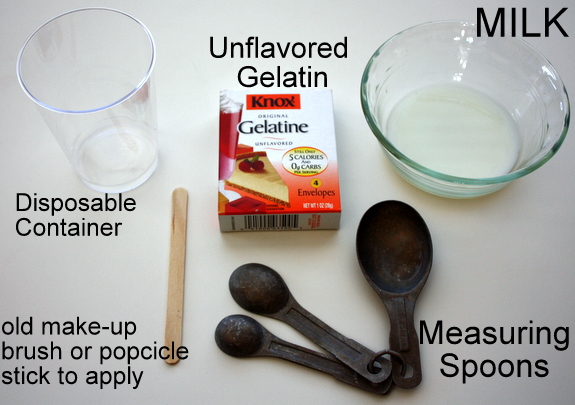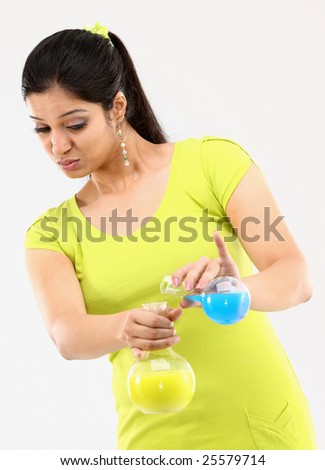Why I Put Foil in the Dryer
Cool DIY ways to do laundry!!
Enjoy!
Friday, February 18, 2011
Wednesday, February 16, 2011
Pesky Black Heads Be Gone...Naturally!
Well this is a natural DIY blog right? So, I just posted about the Biore Strips and fell upon this DIY, natural recipe that does the same thing for a quarter of the price. I LOVE learning new DIY techniques!! LOL
If you have never used bore strips, they are kind of expensive, but I just bought them because I needed them and would stock up whenever I caught them on sale, which they never are. The run about $7-12 for eight-twelve strips. If your like me, I use these strips all over my face therefore I use about 6 at a time.... This adds up.
P.S.
I have used this recipe and it feels like I'm basting a turkey with a brush, lol! And the smell was...odd, but not bad. Besides that, this crap really works and you can see the blackheads, etc that were removed!!
P.S.
I have used this recipe and it feels like I'm basting a turkey with a brush, lol! And the smell was...odd, but not bad. Besides that, this crap really works and you can see the blackheads, etc that were removed!!
Instruction:
1 Teaspoon of milk
Stir together and microwave for 10 seconds
Apply the mixture heavily avoiding your eyes using cosmetic brush
Let it dry for 20 minutes or until completely hardened.
Peel off the gel!
Easy Peasey Lemon Squeezey!!!
Enjoy!
Post & Application Pics by Petit Elefant
Deep Pore Cleansing Strips
This is a cheaper way to do this at home, instead of in a spa. I wish I could get one of those suction things like they have at the spa...... Anyhoo.
Use after a great facial steam and/or cleansing!
Follow this Link for a cheaper DIY natural pore cleansing
Enjoy!
Tuesday, February 15, 2011
Non-Natural Preservative Options
Paraban, Parabans, Parabans!!!! The oh so "evil" Parabans!
First, are they really so bad? Are people just being hypochondriacs and uneducated (not to be mean or derogatory) people making accusations and/or jumping on the bandwagon? Is this whole "organic" & "natural" trend a trend/fad ( with all the new commercialization and propaganda)? Some 'natural" products are not natural or contain less than 5% natural ingredients.....and when small natural companies go mainstream, the formulations change.......I'm just saying( waving white flag, LoL).
I personally try to stay away from them and follow the Curly Girl Do's and Don'ts, however, I'm no chemist, biological study person and I haven't went in any lab to test peoples hypothesis about the chemicals. But what makes me stay away from parabens, "cones", etc is I noticed a different feel in my hair after I stopped using them. My hair felt lighter and I don't have to wash every week, if at all (just co-washing) because of build up. And the creamy crack........just watch the scene of Good Hair when Chris Rock interviews an actual chemist and a production company of relaxers.....I'm just saying.
Anyhoo, I've digressed...again. Here are some non-natural options to preserving your products:
Also, below are some interesting articles I found on the topic. I understand their perspectives. Sometimes you have to choose lesser of two evils and try to keep a good balance (natural vs unnatural preservatives). The fact is, there has not been a broadly successful natural preservative to this date and if you want to sell your products, they must be safe and if it's just for your personal use, it still needs to be safe.
Some more food for thought is the fact that if you make your own products and use synthetic preservatives, etc, they will only count for less that 1% of your total formulations. When you think about it, it's not really that much. ( just playing devils advocate)
Examples:
Germaben II
Germaben II is a convenient, ready-to-use broad spectrum anti-microbial preservative for personal care products such as shampoos, conditioners, lotions, creams, body sprays and other formulations. It is highly effective against gram positive and gram negative bacteria, yeasts and molds and does not need any additional preservatives. It is a clear, viscous liquid with mild odor. It is soluble in both oil/water emulsions and aqueous formulations up to a level of 1.0%. At 1%, Germaben II provides 0.30% Germall II, 0.11% methylparaben, 0.03% propylparaben, and 0.56% propylene glycol. Germaben II should be added slowly to your product under gentle agitation before the addition of fragrance oil.
Recommended usage rates are provided only as guidelines for proper preservation. All new formulations should be challenge tested to ensure preservative efficacy.
INCI Nomenclature: Propylene Glycol (and) Diazolidinyl Urea (and) Methylparaben (and) Propylparaben
Germaben II-E
Recommended usage rates are provided only as a guideline for proper preservation. All new formulations should be challenge tested to ensure preservative efficacy.
INCI Nomenclature: Propylene Glycol (and) Diazolidinyl Urea (and) Methylparaben (and) Propylparaben
LiquaPar Oil
LiquaPar Oil is a clear, liquid blend of isopropyl, isobutyl and n-butyl esters of para hydroxybenzoic acid. It is a very stable and effective preservative against gram positive and gram negative bacteria, yeast and mold. LiquaPar Oil is readily incorporated into various types of formulations, including anhydrous products, without heating. It is a good choice for salt scrubs and bath oils where no water is present but may be inadvertently introduced to the container during regular use. The recommended usage rate is 0.3 - 0.6% however, in complex formulations, 0.1% Germall II may be required for adequate preservation.
Recommended usage rates are meant as guidelines only. All new formulations should be challenge tested to ensure proper preservation.
Sources & Interesting Articles
The Hebarie
From Nature With Love
Natural Preservatives for Cosmetic Recipes
http://www.makingcosmetics.com/articles/01-how-to-use-preservatives-in-cosmetics.pdf
Texas Natural Supply
http://allnaturalbeauty.us/allnaturali.htm
Myth or Fact- Parabens & Cancer by Natural Haven
The Beauty Brains
Handling Diluted and Homemade Products
Enjoy!
Disclamier: These posts are just the result of my research. I make no claims on know all the answers or the best answers to your questions. Use These posts as reference and do your own research.
Natural Preservatives Part 3 (Anti-Microbial Examples and descriptions)
- All microbial growths are not visible to the naked eye, so just because there isn't an odd growth showing up in your products, does not mean that they are not present.
- These occur during daily usage of products; hands in and out of jars, warm moist bathrooms, etc
- Water based products are a breeding ground for microbial growths
Grapefruit Seed Extract
Grapefruit Seed Extract (GSE) is a citrus seed based anti-microbial used as a preservative in skin care products. Use GSE at .5 to 1% to preserve most formulations, or use at 2% to create anti-bacterial creams, salves, rinses and soaps. ( This is a controversial ingredient, some argue that GSE itself is not a preservative, but the synthetic preservative used to preserve GSE itself is actually what assist with product preservation)
Benzoin Resin
found in facial toning and facial oil recipes to improve shelf life.
Potassium Sorbate (USP)
In water potassium sorbate releases sorbic acid which is the active agent. It is a very effective preservative active against molds, yeast and aerophile bacteria in a wide pH range of 2-6.5 and for extended periods of time.
In water potassium sorbate releases sorbic acid which is the active agent. It is a very effective preservative active against molds, yeast and aerophile bacteria in a wide pH range of 2-6.5 and for extended periods of time.
Borax
common ingredient that used to be found on the laundry shelf of most grocery stores. It is a natural cleaner and preservative, and it often found in lotion, cream, bath salt and bath scrub recipes. Also used to aid in emulsification process.
Raw Honey
discourages growth because of low water content and acidity
Neem Oil
anti-microbial
Jojoba Oil
similar to honey, add to fragile oils to improve shelf life.
Essential Oils ( In order to truly be anti-microbials they would have to be used in large quantities, which would irritate our skin)
- Caraway
- Tea Tree Oil
- Cinnamon
- Clove
- Cumin
- Eucalyptus
- Lavender,
- Lemon
- Oregano
- Rose
- Rosemary
- Sage
- Sandalwood
- Thyme
Liquid Germall Plus is a broad spectrum, water soluble preservative for oil-in-water and water-in-oil emulsions and water soluble formulations. It is highly effective against gram positive and gram negative bacteria, yeasts, molds and commonly found organisms. It is compatible with most cosmetic ingredients and has no known inactivators. Liquid Germall Plus is effective at low concentrations of 0.1 - 0.5% (the higher % should be used in conjunction with high protein and complex formulations). It remains active through a pH range of 3-8. It should be added during the water phase or to the emulsified portion of the formulation at a temperpature of 120F or less. Liquid Germall Plus has a safe toxicology profile and has been evaluated as safe for both rinse-off and leave-on formulations. It is a good choice preservative for shampoos, conditioners, lotions, creams, body washes, body sprays and other such formulas.
Sources & Interesting Articles
The Hebarie
From Nature With Love
Natural Preservatives for Cosmetic Recipes
http://www.makingcosmetics.com/articles/01-how-to-use-preservatives-in-cosmetics.pdf
Texas Natural Supply
http://allnaturalbeauty.us/allnaturali.htm
Myth or Fact- Parabens & Cancer by Natural Haven
The Beauty Brains
Handling Diluted and Homemade Products
Enjoy!
Disclamier: These posts are just the result of my research. I make no claims on know all the answers or the best answers to your questions. Use These posts as reference and do your own research.
Enjoy!
Natural Preservatives Part 2 ( Antioxidant Examples and descriptions)
One thing to note about antioxidants is once you open the jar and expose the oils to oxygen, oxidation begins, therefore every time you open the jar for daily use, antioxidants efficacy can decrease.
Examples:
Rosemary Antioxidant Extract
As a preservative, add .15 to .5 % of our undiluted Rosemary oil extract to your products
Shelf-life/Storage: Five years in closed pack under cool storage conditions and exclusion of light.
T-50 Vitamen E Oil
T-50 has a higher content of gamma tocopherols and can be used at a rate of .04% or 400ppm to adequately protect your oils
Sources & Interesting Articles
The Hebarie
From Nature With Love
Natural Preservatives for Cosmetic Recipes
http://www.makingcosmetics.com/articles/01-how-to-use-preservatives-in-cosmetics.pdf
Texas Natural Supply
http://allnaturalbeauty.us/allnaturali.htm
Myth or Fact- Parabens & Cancer by Natural Haven
The Beauty Brains
Handling Diluted and Homemade Products
Enjoy!
Disclaimer: These posts are just the result of my research. I make no claims on know all the answers or the best answers to your questions. Use These posts as reference and do your own research.
Enjoy!
Natural Preservatives Part 1( What exactly do I need to Preserve?)
This topic is so important and seems never ending for those who like to create their own product. In order to cover this topic I will be breaking it down into four post:
I have been researching preservatives for awhile now and although I have not been able to completely figure it out (it is so imprecise, I just want something to say, This will work....).
Anyhoo, this is what I have learned so far:
First, there are two different types of things natural cosmetics need to be protected from, oxidation (shelf life) and microbial growths.
Antioxidants: reduces the rate of oxidation in oils. Oxidation occurs when natural oils and ingredients are exposed to oxygen, thus causing the oil/natural ingredients to degrade and/or spoil. Anti-oxidants can be added directly to your oils or during the oil phase of your oil-water based recipes.
Antimicrobial: destroys and prevents the growth of dangerous micro-organisms like bacteria, yeast, mold, and fungus in your natural cosmetics.
Also, when deciding upon your chosen preservation blend, understand that depending upon your formulation certain mixes/preservatives will not work or lose their efficacy( some mess about chemistry, PH levels, etc). The downside to this is the only way to truly know if your mixes are being preserved correctly is to have them tested by experienced chemist.
Enjoy!
Sources & Interesting Articles
The Hebarie
From Nature With Love
Natural Preservatives for Cosmetic Recipes
http://www.makingcosmetics.com/articles/01-how-to-use-preservatives-in-cosmetics.pdf
Texas Natural Supply
http://allnaturalbeauty.us/allnaturali.htm
Handling Diluted and Homemade Products
- Natural Preservatives Part 1( What exactly do I need to Preserve?)
- Natural Preservatives Part 2 ( Antioxidant Examples and descriptions)
- Natural Preservatives Part 3 (Anti-Microbial Examples and descriptions)
- Non-Natural Preservative Options
I have been researching preservatives for awhile now and although I have not been able to completely figure it out (it is so imprecise, I just want something to say, This will work....).
Anyhoo, this is what I have learned so far:
First, there are two different types of things natural cosmetics need to be protected from, oxidation (shelf life) and microbial growths.
Antioxidants: reduces the rate of oxidation in oils. Oxidation occurs when natural oils and ingredients are exposed to oxygen, thus causing the oil/natural ingredients to degrade and/or spoil. Anti-oxidants can be added directly to your oils or during the oil phase of your oil-water based recipes.
- Fragile oils Examples: almond, hempseed , avocado, flax or evening primrose.
Antimicrobial: destroys and prevents the growth of dangerous micro-organisms like bacteria, yeast, mold, and fungus in your natural cosmetics.
- All microbial growths are not visible to the naked eye, so just because there isn't an odd growth showing up in your products, does not mean that they are not present.
- These occur during daily usage of products; hands in and out of jars, warm moist bathrooms, etc
- Water based products are a breeding ground for microbial growths
Also, when deciding upon your chosen preservation blend, understand that depending upon your formulation certain mixes/preservatives will not work or lose their efficacy( some mess about chemistry, PH levels, etc). The downside to this is the only way to truly know if your mixes are being preserved correctly is to have them tested by experienced chemist.
Enjoy!
Sources & Interesting Articles
The Hebarie
From Nature With Love
Natural Preservatives for Cosmetic Recipes
http://www.makingcosmetics.com/articles/01-how-to-use-preservatives-in-cosmetics.pdf
Texas Natural Supply
http://allnaturalbeauty.us/allnaturali.htm
Handling Diluted and Homemade Products
Disclaimer: These posts are just the result of my research. I make no claims on know all the answers or the best answers to your questions. Use These posts as reference and do your own research.
Tuesday, February 8, 2011
Exfoliants
Ground Oatmeal
Cornstarch
Clays (Bentonite , French Green, Dead Sea, Moroccan, Kaolin,etc)
Sea Salt
Epsom Salt
Spearmint Leafs
Lavender Leafs
Orange Peel Powder
Kelp Granules
Brown Sugar
Almond Meal
Flaxseed Meal
Acidic Juices ( Grapefruit, Lemon, Apple)
Dairy Products ( Milk, Yogurt, Sour Cream)
Enjoy!
Friday, February 4, 2011
I Wish I Hadn't Bought That
We've all done , bought a random product off the shelf or read some amazing product review that promised all these great results, but when you get home and try it, it's a whole different story.
But what do you do with it after you realize it sucks. If it was a $50 dollar jar of "miracle" crap, I don't know about you, but I ain't throwing away my money or just giving it away. So, I say figure out what it's missing and add it.
If it's too drying, add your favorite moisturizer, if it lacks slip (conditioners) add a little of your favorite conditioner or marshmallow root extract. The possibilities are endless!!
I recently brought a shampoo last weekend that was too strong and drying for my hair. It was natural, paraban, sulfate, etc free liquid black soap. But I was so determined to try liquid black soap that I ignored the product description about being for dandruff, eczema, etc types and bought it. I don't suffer from these things, but I figured if I didn't like it my mom could use it because she does, right?
Anyhoo, neither of us liked it so, I plan to add some Shea Oil, a touch of Vegetable Glycerin or honey, and Castor Oil to the shampoo to add moisture to the shampoo.
Other Fix it ideas:
Eco Styler Gel too Drying?
- mix it with an oil, leave-in conditioner or Shea Butter
Greasy Lotion
- Add more Shea butter to spread it out
- Add Water and emulsifying wax
Lacks desired Herbal Benefits:
- Add EO Blends
- Add Floral Water, Decoction, Tincture, Infusion
- Add Herbal Extracts
Enjoy!
Create Your Own Using a Base
Some of you might know that I have been really intrested in creating my own shampoo lately, however after reading all this information on bacterial, mold, etc. growths that occur in unpreserved water based products I have been scared off from creating them myself. Because I do this for my own pleasure and have no desires about selling my recipes, I am not willing to pay all the money required to find that right recipe with the correct preservative and amounts.
So why not let someone else figure it out, right?
Look for good base soaps that interest you and contact the seller about the percentages of additives that you could add to the base without compromising the soap and preservative. Some natural vendors will have this information included in their product decriptions or you could just ask them. Some Etsy vendors offer custom orders also! Be careful to look at the ingredients list for base products becasue some are not all natural and contain harsh surfactants.
So instead I have decided to buy base soaps and add my own herbal blends that I desire to make it my own!!!
I recently order Liquid Black Soap and Shea Butter Liquid Soap from Shea Essentials to test my theory. If I like the soap(s), they provide the option of buying the soap base in bulk!! So you can buy a years supply and cut down on shipping costs, thus being green!
I also like that she tells you the amount of additives you can add to her product and most importantly, SHELF LIFE ( If your a germaphobe like me and get easily scared by health info, this is important to know!)
Enjoy!
Thursday, February 3, 2011
Current Store Bought Fav's for Hair
I can't make it all, LOL..... So here are some of my favorite store bought products (most are natural, but some....aren't).
Kinky Curly Knot Today- Great moisturizing leave-in, Smooths hair cuticle for styling!
Shea Moisture Raw Shea Butter Restorative Conditioner - great moisturizing leave-in and conditioner. Leaves hair very soft and can be used as either a leave-in or rinse out conditioner!
Aloe Vera Gel- Provides light hold for wash n gos and those edges and provides moisture
Herbal Essence Hello Hydration- hands down best co-wash conditioner
Aussie Moist Conditioner - great co-wash conditioner
Eco Styler Gel- holds those edges, helps define curls (downside, can be drying, I usually mix with a oil before application)
Carol's Daughter Honey Pomade- use to smooth cuticle for french twists and soften edges ( good for when you straighten your natural hair to add luster without water)
Allaffia Virgin Coconut & Shea Daily Hydrating Conditioner- smells great and softens hair
VO5 Clarifying Conditioner- gives the hair a nice clean feeling w/o stripping it ( only works for those without product build up)
Suave- light and use this most times to make my Leave-in spritz or when out of town and didn't bring anything ( won't be mad about leaving it behind, because I have carry-on luggage), etc
Items Considering/Interested In:
Deva Set- it Free
Deep Conditioner Elasta QPR-DP11 (something like that, LOL)
Kiss My Face Gel
Allafia Shampoos
Curls Cleansing Cream
Shea Moisture Curl Define Cream( something like this)
Shea Moisture Control Paste
Giovanni Conditioners, Shampoo and Styling Lotion
Jane Carter Wrap & Roll
KeraCare Naturals Twist & Define
KeraCare Naturals Textures Cleansing Cream
Sista Roberta's Hair Pudding Conditioner & Conditioning Shampoo
What are your favorites?
Kinky Curly Knot Today- Great moisturizing leave-in, Smooths hair cuticle for styling!
Shea Moisture Raw Shea Butter Restorative Conditioner - great moisturizing leave-in and conditioner. Leaves hair very soft and can be used as either a leave-in or rinse out conditioner!
Aloe Vera Gel- Provides light hold for wash n gos and those edges and provides moisture
Herbal Essence Hello Hydration- hands down best co-wash conditioner
Aussie Moist Conditioner - great co-wash conditioner
Eco Styler Gel- holds those edges, helps define curls (downside, can be drying, I usually mix with a oil before application)
Carol's Daughter Honey Pomade- use to smooth cuticle for french twists and soften edges ( good for when you straighten your natural hair to add luster without water)
Allaffia Virgin Coconut & Shea Daily Hydrating Conditioner- smells great and softens hair
VO5 Clarifying Conditioner- gives the hair a nice clean feeling w/o stripping it ( only works for those without product build up)
Suave- light and use this most times to make my Leave-in spritz or when out of town and didn't bring anything ( won't be mad about leaving it behind, because I have carry-on luggage), etc
Items Considering/Interested In:
Deva Set- it Free
Deep Conditioner Elasta QPR-DP11 (something like that, LOL)
Kiss My Face Gel
Allafia Shampoos
Curls Cleansing Cream
Shea Moisture Curl Define Cream( something like this)
Shea Moisture Control Paste
Giovanni Conditioners, Shampoo and Styling Lotion
Jane Carter Wrap & Roll
KeraCare Naturals Twist & Define
KeraCare Naturals Textures Cleansing Cream
Sista Roberta's Hair Pudding Conditioner & Conditioning Shampoo
What are your favorites?
Wednesday, February 2, 2011
Whipped Body Butter
I have tried two other body butter recipes, which I liked, but I still found that my skin cracked in some places due to the extremely cold weather we have been having in Chicago. For this recipe I will be trying a different process and ingredients:
Ingredients:
I have to admit this mix is very thick, but dries non-greasy on skin. A little goes a long way!
Enjoy!!
Ingredients:
- 4oz Shea Butter
- 3oz Mango Butter
- 2 Tbsp Aloe Vera Gel
- 1 tbsp Castor Oil
- 1tsp Jojoba Oil
- 1 tsp Grapeseed Oil
- 1 tsp Vitamin E Oil
- EO of choice
- 1% Optiphen (preservative)
- Measure out butter using scale
- Soften Butters in Microwave on low heat for 10-30 seconds or using a double boiler
- Place butters in bowl and whip with your mixer on high for 5 minutes
- Add EO to carrier oil of choice and mix
- Add preservative(s) of choiceand mix
- Place Whipped Shea butter in clean jar
I have to admit this mix is very thick, but dries non-greasy on skin. A little goes a long way!
Enjoy!!
Subscribe to:
Posts (Atom)










